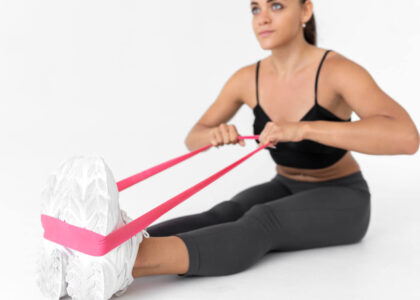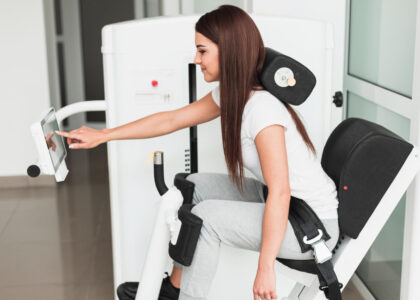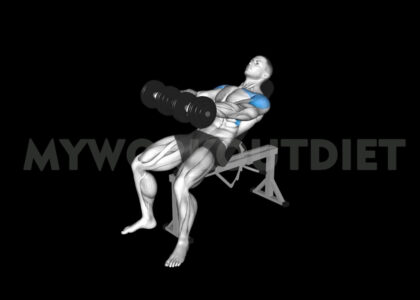CALVES | DEADLIFT | BICEPS | TRICEPS | BACK | ABS | BELLY
Today, we will focus on an important and overlooked aspect of your upper body: the rhomboid muscles. If you want to develop a more muscular, defined upper back and correct your posture, you’ve come to the right place.
The rhomboid muscles in our upper back play a pivotal role in maintaining good posture and healthy shoulders. Neglecting these muscles can lead to poor posture, imbalances, and discomfort or pain. However, with the right exercises and dedication, you can strengthen your rhomboids and enhance your upper back’s aesthetics.
This article will explore the 5 best rhomboid exercises to help you target and develop these crucial muscles. Whether you’re a seasoned gym-goer or just starting your fitness journey, these exercises are adaptable to your fitness level and goals.
Understanding the Rhomboid Muscles
Before we delve into the exercises, it’s crucial to grasp the anatomy and function of the rhomboid muscles. These muscles, namely the rhomboid major and minor, are located in the upper back and connect the shoulder blades (scapulae) to the spine.
Understanding their role is fundamental to appreciating why rhomboid exercises are beneficial.
Anatomy of the Rhomboid Muscles:
Rhomboid Major : This broad, flat muscle lies beneath the trapezius and attaches the inner edges of the scapulae to the spine’s thoracic vertebrae (T2 to T5). It’s responsible for retracting or squeezing the shoulder blades together.
Rhomboid Minor : Situated just above the rhomboid major, it connects the scapulae to the cervical spine’s spinous processes. This muscle’s primary function is to help with scapular retractions.
The Role of Rhomboid Muscles :
The rhomboid muscles play several crucial roles in maintaining normal upper body function.
Posture Support : By pulling back the shoulder blades and stopping them from sloping forward, these muscles help in maintaining good posture. Weak rhomboid muscles can lead to poor posture and rounded shoulders.
Shoulder Stability : Strong rhomboids are essential for shoulder stability, which lowers the risk of injury during various upper body activities.
Improved Upper Back Aesthetics : Developing well-defined rhomboid muscles can lead to a more sculpted upper back appearance, enhancing your overall physique.
Benefits of Rhomboid Exercises
Let’s explore the compelling benefits of adding rhomboid workouts to your fitness routine.
1. Improved Posture:
One of the most noticeable advantages of training your rhomboid muscles is the significant improvement in your posture. In our modern, sedentary lifestyles, many find themselves slouched over desks or bending forward while using smartphones and computers. Weak rhomboids can increase these posture problems, resulting in rounded shoulders and soreness in the upper back.
By regularly performing rhomboid exercises, you’ll feel better scapular retraction, pulling your shoulder blades back and down. This, in turn, promotes an upright posture, aligning your spine and reducing the strain on your neck and shoulders. Good posture not only makes you look more confident but also helps in preventing long-term musculoskeletal issues.
2. Enhanced Shoulder Health:
Stable and functioning of shoulders depend on rhomboid solid muscles. To ensure smooth, controlled movements of the shoulder joint. These muscles work together with other shoulder and back muscles. When the rhomboids are weak, it can result in imbalances and potentially increase the risk of shoulder injuries, such as impingements and rotator cuff problems.
Adding rhomboid exercises into your routine can help you avoid these problems by promoting balanced shoulder muscle development. This increased stability may be beneficial if you engage in tasks that require overhead movements or heavy lifting.
3. Aesthetically Upper Back:
Strong rhomboid muscles are crucial if you want a well-defined back and a contoured upper torso. These muscles play a significant role in creating the “V” shape that many fitness enthusiasts desire. Your upper back’s muscle definition and symmetry will increase as you develop your rhomboids, which can improve your overall physique.
4. Reduced Pain and Discomfort:
If you spend a lot of time at a desk or engage in activities that put a lot of strain on your upper body, your weak rhomboids may be a factor in your upper back and neck discomfort. Strengthening these muscles helps ease this discomfort by providing better support to the upper back and shoulders.
5. Improved Athletic Performance:
Strong rhomboids can improve your performance whether you’re an athlete or live an active lifestyle. These muscles are crucial for shoulder stability and efficient movement, essential for weightlifting, swimming, and even yoga.
Proper Warm-Up
Before you get into the 5 best rhomboid exercises, preparing your body with a proper warm-up routine is essential. Warming up is necessary for the following reasons:
Here’s a recommended warm-up routine to prepare your body for rhomboid exercises:
1. Cardiovascular Warm-Up (5-10 minutes):
Begin with 5-10 minutes of light cardio exercise, such as jogging, jumping jacks, or brisk walking. These exercises increase your body temperature and heart rate.
2. Dynamic Stretches (3-5 minutes):
Dynamic stretches, such as arm circles, shoulder rolls, and neck tilts, should be done for 3-5 minutes to target your upper body. These exercises increase joint flexibility and get your shoulders ready for workouts.
3. Activation Exercises (3-5 minutes):
Engage the muscles you’ll be training. For rhomboid exercises, try scapular retractions. Stand or sit up straight, retract your shoulder blades by pulling them back and down, and then release. Repeat this motion several times to activate your rhomboids.
4. Targeted Rhomboid Warm-Up (2-3 minutes):
Before beginning the main workouts, perform a few repetitions of a basic variation of the rhomboid movements you’ll be doing. This gets your rhomboid muscles accustomed to the movement pattern.
Spending 15-20 minutes on this warm-up technique can significantly reduce your risk of injury and ensure the efficacy of your rhomboid exercises.
The 5 Best Rhomboid Exercises
In this section, we’ll get into the core of our article—the 5 best rhomboid exercises. These exercises are carefully selected to target your rhomboid muscles effectively, helping you build a solid and sculpted upper back.
1. Dumbbell Rows:
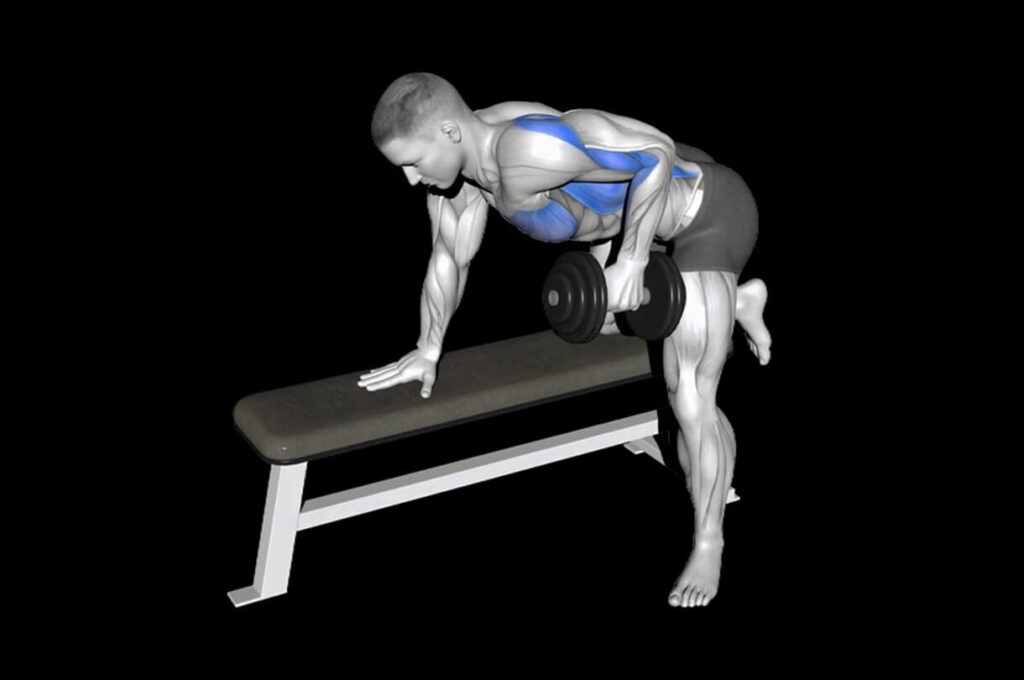
- First, choose a dumbbell according to your strength and grab it with your right hand.
- Then, place your left knee on the table perpendicular to the buttocks.
- Lower your upper body and put your left hand perpendicular to the left shoulder, as shown in the above image.
- Keep your right leg to the side to balance your body while performing this exercise.
- Exhale and lift the dumbbell towards the lower back. Continue lifting the dumbbell until your elbow crosses the torso.
- Hold for a second and lower the dumbbells with control to the starting point for completing one rep.
- After completing the desired amount of reps, switch sides and perform the same movement to the other side (left).
Benefits: Dumbbell rows are excellent for targeting the rhomboids and building a solid and muscular back.
Tips: Keep your spine neutral, and contract your abs for stability. Concentrate on the squeeze at the top of the movement to activate your rhomboid muscles most actively.
2. Face Pulls:
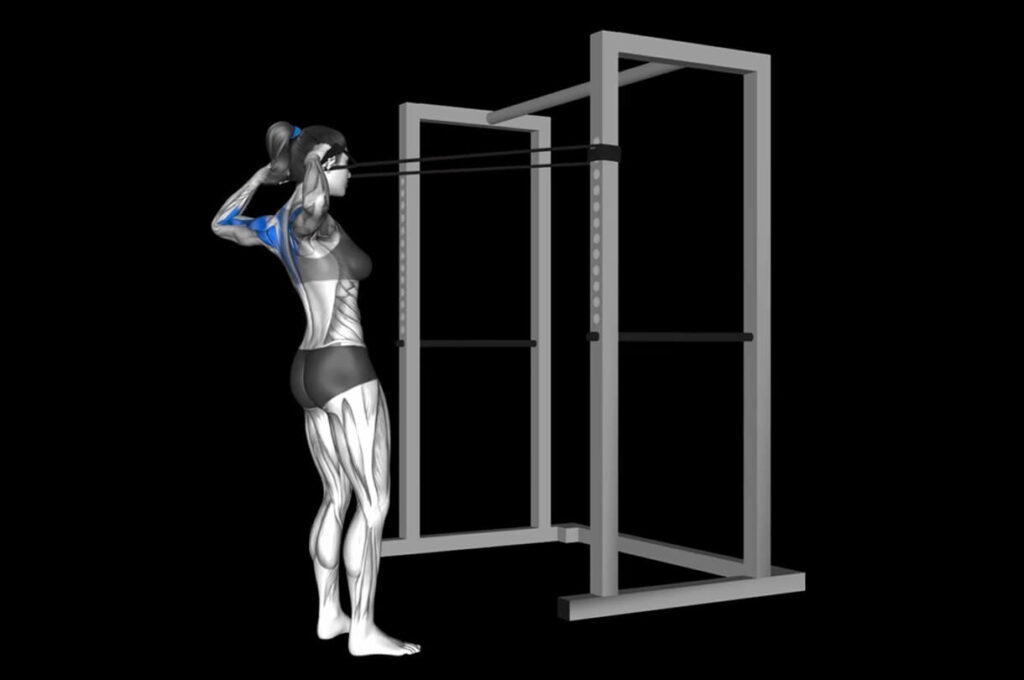
- For performing this exercise (face pull), attach a rope handle to a cable machine at shoulder height.
- Hold an overhand grip on the rope’s ends and take a few steps back.
- Exhale and pull the cord toward your face.
- Continue pulling the rope until you feel a significant contraction in your shoulder blades, or try touching the rope’s centre with your forehead.
- Focus on squeezing your shoulder blades together.
- Inhale and, with control, go back to the beginning position.
Benefits: Face pulls are very beneficial for rhomboid development and shoulder health.
Tips: Keep your wrists straight and your elbows up. Focus on the contraction of your rhomboids as you pull the rope towards your face.
3. Bent Over Rows:
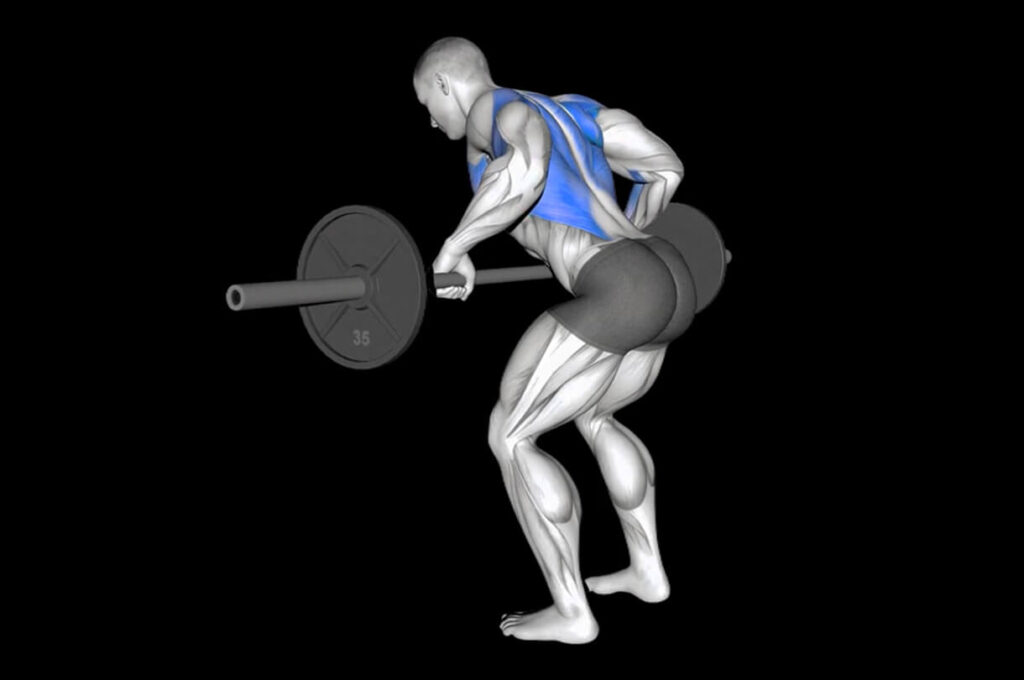
- Place a barbell on the floor and load it with plates according to your capacity.
- Stand near the road by placing feet with buttocks width apart.
- Hold the barbell with an overhand grip by lowering your body. With chest up, butts down and back straight, lift the barbell like a deadlift.
- Slightly bend your knees, lean your upper body forward and control the whole weight on your thighs.
- Exhale, and pull the weight towards your hips with your elbows. Continue pulling until the bar touches your abdomen.
- Hold shoulder blades at the top in a contracted position for a second.
- Inhale and lower the weight back down by extending your arms under control.
Benefits: Bent-over rows engage the rhomboids while working the lower back and biceps.
Tips: Maintain a slight knee bend and keep your chest up. Pull the weight with control and avoid using momentum.
4. Seated Cable Rows:
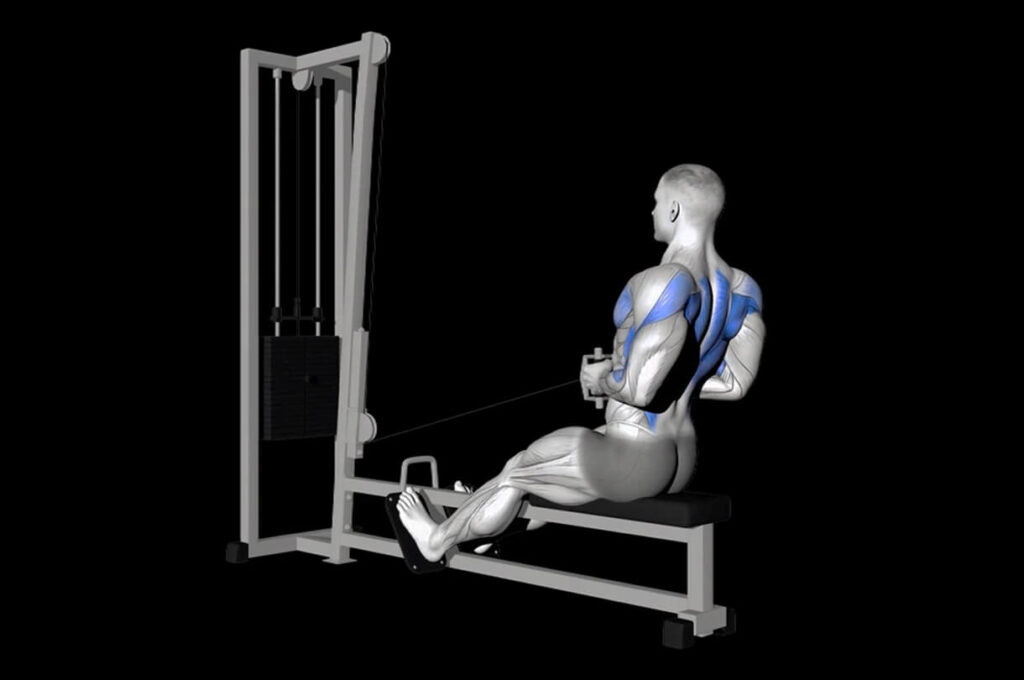
- Sit at a cable row machine with feet on the platform and a slight bend in your knees.
- Grab the handles with an overhand grip.
- Exhale, and pull the handles towards your lower rib cage. Continue pulling handles until your elbows cross your torso.
- Contact the shoulder blades and pause to feel the muscles tightening.
- Inhale, and return to the starting point by extending your arms and engaging the targeted muscles.
Benefits: Seated cable rows provide a controlled and consistent tension on the rhomboids, promoting muscle growth.
Tips: Keep your back straight and your torso stable. Pull the handles in your direction while paying attention to your rhomboids contracting.
5. T-Bar Rows:
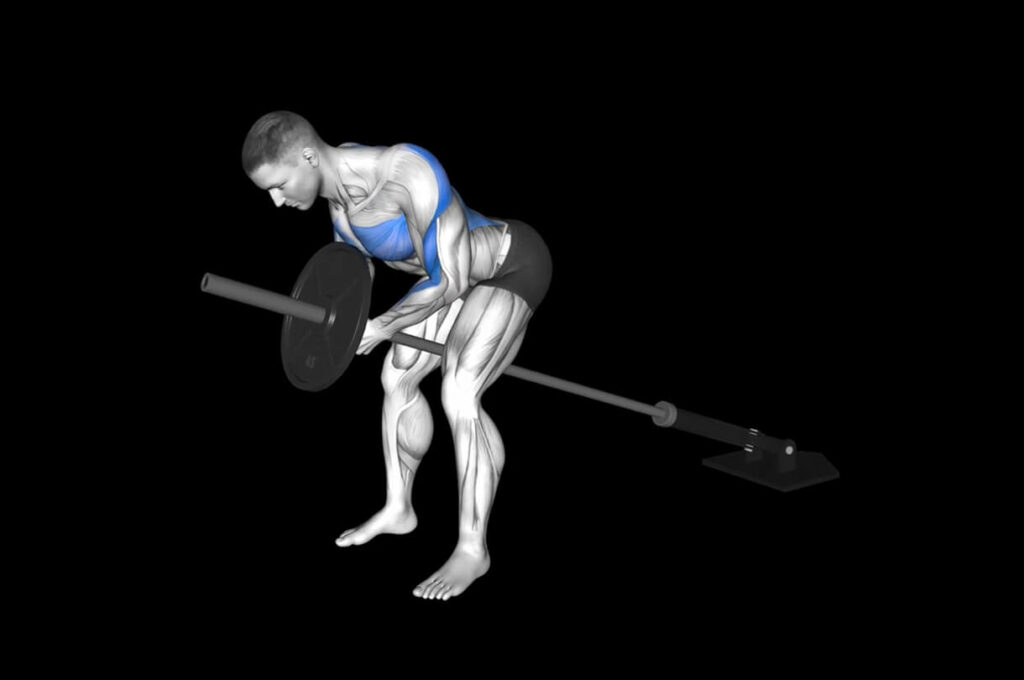
- Place a rod in any corner and put the weight at the corner so the rod is at its position during exercise.
- Load weight according to your capacity and place the handle under the rod.
- Stand with feet hip-width apart, straddling the bar.
- Grab the handles with both hands. The handle should be near the plates.
- Pull the weight towards your torso, and continue lifting until you feel significant contraction in your upper back muscles.
- Pause at the top for a second and then return to the starting point.
Benefits: T-Bar rows are a compound exercise that targets the lats, traps, and rhomboids.
Tips: Keep your spine neutral and engage your core. Control the weight and avoid using momentum throughout the range of motion.
Common Mistakes to Avoid
It’s essential to be aware of common mistakes that might hinder your progress and result in injury as you start performing rhomboid muscle workouts. Here are some catches to stay away from:
1. Poor Posture:
Mistake: During exercises, rounding your back or leaning your shoulders.
Consequence: This places excessive strain on your lower back and reduces the effectiveness of the rhomboid exercise.
Tip: Maintain good posture throughout each exercise. Keep your shoulder blades retracted, chest up, and back straight.
2. Using Incorrect Form:
Mistake: Swinging weights, using momentum, or ignoring form for greater loads.
Consequence: Improper form decreases rhomboid muscle engagement and increases the risk of injury.
Tip: Start with a weight that allows you to complete each rep with proper form. Focus on controlled, methodical motions.
3. Neglecting Warm-Up:
Mistake: Skipping or rushing through the warm-up phase.
Consequence: Skipping warm-up increases the risk of muscle strains and injuries.
Tip: Take enough time to warm your body with cardiovascular exercises, dynamic stretches, and muscle activation exercises.
4. Overtraining:
Mistake: Excessively training the rhomboids without enough rest and recovery.
Consequence: Overtraining can lead to muscle fatigue, poor performance, and increased risk of injury.
Tip: Include rhomboid exercises into your workout routine 2-3 times per week, allowing 48 hours of rest between sessions.
5. Insufficient Range of Motion:
Mistake: Performing exercises with limited range of motion.
Consequence: This reduces the effectiveness of the practice and limits muscle engagement.
Tip: Ensure you perform each rep through its full range of motion to effectively target the rhomboid muscles.
6. Ignoring Pain Signals:
Mistake: Pushing through sharp or persistent pain during exercises.
Consequence: Ignoring pain can lead to severe injuries or aggravate existing conditions.
Tip: Stop the exercise immediately, and see a doctor if you have pain beyond simple muscle soreness.
7. Not Progressing Gradually:
Mistake: Sticking with the same weight and intensity for an extended period.
Consequence: Your muscles will adapt, which could cause your progress to slow down.
Tip: To continue gaining strength, gradually increase the weight or intensity of your rhomboid exercises.
Stretches for Rhomboid Muscles
Performing Stretching helps improve flexibility, reduce muscle tension, and prevent overuse injuries. The following are some excellent rhomboid stretches to incorporate into your exercise routine:
1. Standing Wall Stretch:
Execution:
- Stand about 3-foot steps away from a wall.
- Put your palms at shoulder height on the wall.
- Slowly walk your feet back while keeping your hands on the wall until you feel a gentle stretch in your rhomboid muscles.
Hold: Hold the stretch for 15-30 seconds.
Repeat: Repeat 2-3 times.
2. Seated Rhomboid Stretch:
Execution:
- Sit on the ground and extend your legs in front of you.
- Put your right foot on the outside of your left thigh while bending your right knee.
- Place your left elbow outside your right knee and rotate your upper body to the right.
- Gently press your knee to deepen the stretch in your rhomboid muscles.
Hold: Hold the stretch for 15-30 seconds on each side.
Repeat: Repeat 2-3 times on each side.
3. Child’s Pose:
Execution:
- Start kneeling with your big toes in contact and knees apart.
- Sit back on your heels and place your arms forward on the floor.
- Lower your chest toward the ground, allowing your forehead to touch the base.
Hold: Hold the stretch for 30 seconds to 1 minute.
Repeat: Repeat as needed for relaxation and muscle release.
4. Chest Opener Stretch:
Execution:
- Stand with your feet shoulder-width apart.
- Move your arms backward and Clasp your hands by straightening your arms.
- Pulling your shoulder blades together, lift your arms slightly and open your chest.
Hold: Hold the stretch for 15-30 seconds.
Repeat: Repeat 2-3 times.
5. Cat-Cow Stretch:
Execution:
- Come to the tabletop position. Palms and knees touching the ground.
- Lift your head and tailbone by taking a deep breath in.
- As you round your back and drop your chin into your chest, exhale. (Cat Pose).
- Alternate between the two poses for 30 seconds to 1 minute.
Repeat: Repeat as needed for spine mobility and rhomboid relaxation.
Must Try Above Rhomboid Exercises
This comprehensive guide explored rhomboid exercises, highlighting their importance for posture, shoulder health, and overall fitness. We’ve also provided a selection of the best rhomboid activities, highlighted common mistakes to avoid, and offered practical tips on incorporating these exercises into your fitness routine.
Remember that building a strong upper back, including well-developed rhomboid muscles, is not just about aesthetics; it’s about enhancing your overall well-being. Your upper back plays a vital role in maintaining proper posture, preventing injuries, and supporting various physical activities.




